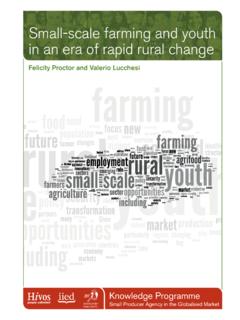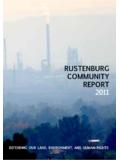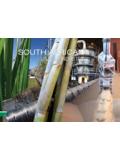Transcription of FAO Aquaculture Newsletter, October 2018 - No. 59
1 October 2018. No 59. FA N. FAO Aquaculture Newsletter In this month's issue Opportunities for Aquaculture Development in Drylands ii Overview of Recently Published Global Aquaculture Statistics 6. The Development of Small-Scale Trout Farming in Kyrgyzstan 18. Rice-fish Farming in Iran: History and Development 28. Development of Mariculture in Zanzibar, Tanzania 41. Preparation of the State of the World Report on Aquatic Genetic Resources 46. EDITORIAL. FAO/V. CRESPI. Aquaculture facility in arid lands in Egypt FAO. Opportunities for Aquaculture Development in Drylands A quaculture the fastest growing major food industry for decades, currently produces of offshore Aquaculture usually requires high initial costs and investments not always affordable of the world population (313 million).
2 Lives in arid zones with 92 million residing in hyper-arid deserts (UNDP/. 53 percent of the global fish we by small-medium scale investors and UNSO). Deserts cover more than one consume and it is largely responsible at times, not technically feasible nor fifth of the Earth's land, they are for doubling the per capita fish economically attractive. Although found on every continent and they consumption of fish products since marine Aquaculture offers great can represent new unexploited areas 1960s (SOFIA, 2018)1. The global opportunities for development in for development. population growth and increase in term of high value species, revenues food demand is driving the rapid and creation of employment it may Arid lands are characterized development and intensification not, at least for now, fill the gap of by high temperature variations of Aquaculture towards new fish needs of those populations living (between day and night); low geographical frontiers.
3 In inland marginal regions such as precipitations; high solar radiation arid lands. and evaporation; limited surface When we consider expansion of the water; abundant inexpensive land;. sector as a whole, we immediately Drylands take up percent of often with large aquifers of fresh think of offshore Aquaculture due the world land surface and up and brackish water. Ground water to the large extension of the oceans to 44 percent of all the world's in these environments is often only and areas with limited conflicts of cultivated systems are in the drylands partially used although this water use. However, the development (United Nations)2.
4 Thirteen percent is abundant and of high quality. The designations employed and the presentation of material in this FAO encourages the use, reproduction and dissemination of material information product do not imply the expression of any opinion whatsoever in this information product. Except where otherwise indicated, material on the part of the Food and Agriculture Organization of the United Nations may be copied, downloaded and printed for private study, research and (FAO) concerning the legal or development status of any country, territory, teaching purposes, or for use in non-commercial products or services, city or area or of its authorities, or concerning the delimitation of its provided that appropriate acknowledgement of FAO as the source and frontiers or boundaries.
5 The mention of specific companies or products of copyright holder is given and that FAO's endorsement of users' views, manufacturers, whether or not these have been patented, does not imply products or services is not implied in any way. that these have been endorsed or recommended by FAO in preference to others of a similar nature that are not mentioned. All requests for translation and adaptation rights, and for resale and other commercial use rights should be made via: The views expressed in this information product are those of the author(s) or addressed to and do not necessarily reflect the views or policies of FAO.
6 FAO information products are available on the FAO website FAO, 2018 ( ) and can be purchased through ii COVER PHOTO: Farmed Nile tilapia (Oreochromis niloticus) in Bangladesh, HASAN. EDITORIAL. FAO/V. CRESPI. agriculture has become In many countries of the Near East more popular in areas where and North Africa, governments Fish market in Kuwait City, Kuwait water and other resources are strongly supporting the are limited. Aquaculture development of freshwater Nowadays drylands can be better in arid lands can provide social Aquaculture particularly in marginal exploited for food production using benefits, assuring an improved public regions such as desert and arid modern and responsible Aquaculture health and food security for rural lands.
7 The increasing competition practices such as integrated communities reducing migration for land, water and natural Aquaculture systems which follow of vulnerable population especially resources will require the application agroecology principles3, reducing youth and women, towards cities of new strategies including water use in support to food safety and/or abroad. promotion of efficient use of and environmental protection and resources, recycling and enhancing conservation. These integrated In these areas aquatic food does biodiversity to ensure adequate farming systems can produce a not easily reach local markets food production protecting cheap and affordable source of and there is a low tradition in fish livelihoods and social systems and quality protein and fresh vegetable consumption.
8 Moreover available promoting responsible governance. products with reduced water and fish is often in the form of frozen resources use especially small-scale products (sardines or tilapia) and farm households in rural areas. often of poor quality. People are Integrated multi-trophic Aquaculture usually not aware of the high (IMTA)4 also offers the opportunity nutritional value of fresh fish and Valerio Crespi to produce high quality crops taking the role fish plays in the optimal Chief Editor advantage of synergistic interactions development of the brain and FAO Fisheries and Aquaculture Department among the species.
9 Also, renewable neural system of children. E-mail: energy such as solar, geothermal and wind power allows the SEE ALSO. intensification of production without depending on standard 1. FAO. 2018. The State of World Fisheries and Aquaculture 2018 - Meeting the sustainable development goals. Rome. sources of energy. 2. United Nations webpage: 3. FAO Agroecology Knowledge Hub: In the last two decades, the 4. Integrated Multi-trophic Aquaculture integration of Aquaculture with FAO/V. CRESPI. Women visiting an Aquaculture facility in the District of Ouargla, Algeria FAO Aquaculture NEWSLETTER No. 59 October 2018 iii CONTENTS.
10 Editorial Oportunities for Aquaculture Development in Drylands ii GLOBAL Aquaculture . UPDATES 6. FAO/F. MASSA. From the Statistician's Desk Overview of Recently Published Global Aquaculture Statistics 6 Aquaculture cages in Samsun, Turkey From the Fish Health Specialist's Desk Aquaculture UPDATES Europe FAO Continues Efforts to Build Capacity BY REGION 15 Technical Training on Turbot Farming in Dealing with Tilapia Lake Virus 8 and Restocking in Trabzon, Turkey 21. Asia-Pacific Meetings/events The Pacifc Micronesian Association for Regional Workshop on Market Access Thirty-third Session of the FAO and Fish Trade for Central and Sustainable Aquaculture : Aquaculture Committee on Fisheries (COFI 33) 10 Eastern Europe 22.

















